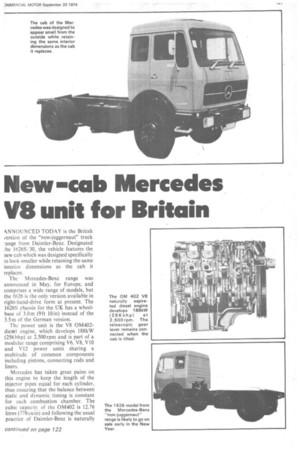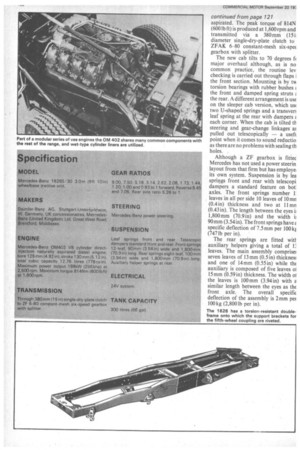New-cab Mercedes VS unit for Britain
Page 123

Page 124

If you've noticed an error in this article please click here to report it so we can fix it.
ANNOUNCED TODAY is the British version of the "non-juggernaut" truck range from Daimler-Benz. Designated :he 1626S/30, the vehicle features the new cab which was designed specifically to look smaller while retaining the same interior dimensions as the cab it replaces.
The Mercedes-Benz range was announced in May, for Europe, and comprises a wide range of models, but the 1626 is the only version available in right-hand-drive form at present. The 1626S chassis for the UK has a wheelbase of 3.0 m (9 ft 10 in) instead of the 3.5 m of the German version.
The power unit is the V8 0M402diest1 engine, which develops 188kW (256 bhp) at 2,500 rpm and is part of a modular range comprising V6, V8, VIO and V12 power units sharing a multitude of common components including pistons, connecting rods.and liners.
Mercedes has taken great pains on this engine to keep the length of the injector pipes equal for each cylinder, thus ensuring that the balance between static and dynamic timing is constant for each combustion chamber. The cubic capacit% of the 0M402 is 12.76 litres (778 cu in) and following the usual practice of Daimler-Benz is naturally aspirated. The peak torque of 814N (600 lb ft) is produced at 1,600 rpm and transmitted via a 380mm (15i diameter single-dry-plate clutch to ZFAK 6-80 constant-mesh six-spec gearbox with splitter.
The new cab tilts to 70 degrees fi major overhaul although, as is no common practice, the routine lev checking is carried out through flaps I the front section,, Mounting is by tv, torsion bearings with rubber bushes g the front and damped spring struts the rear. A different arrangement is use on the sleeper cab version, which us two U-shaped springs and a transven leaf spring at the rear with dampers g each corner. When the cab is tilted tI steering and gear-change linkages at pulled out telescopically — a useft point when it comes to sound reductio as there are no problems with sealing th holes.
Although a ZF gearbox is fittec Mercedes has not used a power steerin layout from that firm but has employe, its own system. Suspension is by lea springs front and rear with telescopi dampers a standard feature on bot axles. The front springs number 1 leaves in all per side 10 leaves of 10 mr (0.4 in) thickness and two at 11 mr (0.43 in). The length between the eyes 1,800mm (70.9 in) and the width i! 90 mm (3.54in). The front springs have specific deflection of 7.5 mm per 100 ki (747 lb per in).
The rear springs are fitted witl auxiliary helpers giving a total of leaves. The main assembly comprise! seven leaves of 13mm (0.5 in) thicknest and one of 14 mm (0.55in) while thc auxiliary is composed of five leaves o1 15 mm (0.59 in) thickness. The width oi the leaves is 100 mm (3.94 in) with a similar length between the eyes as th( front axle. The overall specific deflection of the assembly is 2mm pet 100 kg (2,800 lb per in).




































































































































































































































































































































































